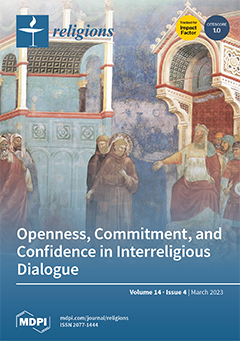In at least two aspects, Buddhist Avadāna literature shares a strong affinity with Chinese literature. One type of stories can be seen as parallel tales that bear striking resemblances to Chinese tales, while the other type has been assimilated by Chinese writers and
[...] Read more.
In at least two aspects, Buddhist Avadāna literature shares a strong affinity with Chinese literature. One type of stories can be seen as parallel tales that bear striking resemblances to Chinese tales, while the other type has been assimilated by Chinese writers and transformed into Chinese tales. Regarding the first kind, there are many parallels between Buddhist and Chinese stories throughout the Six Dynasties (222–589), and it was only later that these stories were somehow compiled into collections that brought these parallels to light. As an example of the second type, in
linggui zhi 靈鬼志 (
The Record of Magical Ghosts) of the Jin Dynasty (265–402), the story of
waiguo daoren 外國道人 (“the Foreign Master”) adapts the magical plot in which a man throws up a jug from the story of
fanzhi tuhu 梵志吐壺 (“a Brahmin Spits a jug”) in the Buddhist text, yet it changes certain objects of the story to items with Chinese characteristics and develops new meaning. In
Xu qixiezhi 續齊諧志 (
Further Records of Qixie [Supernatural tales]), the famous
e’long shusheng 鵝籠書生 (“the Goose Cage Scholar”, also known as the
yangxian shusheng 陽羨書生” (the Scholar from Yangxian)”), takes the same story to another level. The structure of the story is changed, and a number of literati aesthetic interests are added, improving the literary color, smoothing down the language, and making substitutions in the text’s specifics, thus, bolstering the sense of realism and history. Meanwhile, in Liu Yiqing’s 劉義慶 (403–444)
Xuanyan ji 宣驗記 (
Records Manifest Records of Manifest Miracles), the Avadāna tale
yingwu jiuhuo 鸚鵡救火 (“the Parrot Putting Out the Fire”) that he collected is not only associated with Buddhism but can also be seen as a commentary on the turbulent times and a hint of literati optimism if we view it in the context of Liu Yiqing’s
Youminglu 幽明錄 (
Record of the Hidden and Visible Worlds). The literary elites of the Six Dynasties drew inspiration from Buddhist Avadāna sources and imaginatively mixed them with historical circumstances to create Chinese fiction with new intentions. The rich resources of Avadāna literature from India and the fable tradition in Chinese literature create cultural conditions for these two sources to combine and mutually develop, forming a world of literature with colorful and meaningful stories.
Full article





